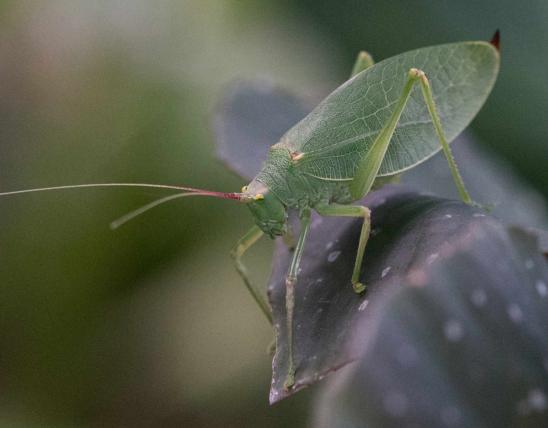Katydids are a species of insects associated with grasshoppers and crickets. In some areas, they have also been termed bush crickets or long-horned grasshoppers. They are giant insects, at least two inches in size from head to wingtips. They are light green with a triangular shape in the side view, which leads to another common name for the species – “greater angle-wing katydid.” The hind legs are long and slender, and the femur is dense for jumping. The antennas are very long and thread-like. Even when not seen, the broad-winged katydid is one of Colorado’s most recognizable insects, making clicking sounds in trees and bushes in late summer.
Angle wing katydid Eggs
Angle wing katydid eggs are also a unique stage of this insect. They are arranged in both flat and medium-sized, double-leafed rows, implicative of fish scales. Eggs are initially black but quickly turn creamy.
The overwintering stage of katydids is eggs that are produced on twigs and small branches. The eggs hatch next spring, and the growing katydids emerge during the season, converting to full-grown in late summer. Although katydids graze on leaves, they are never ample enough to cause significant damage to plants. Katydids may feed on some small insects found on the plants.
They lay their eggs by roughening the bark and sticking the eggs to the host plant branches. Adults die from colds in September and early October, and one generation is born per year.
Angle wing katydid Life cycle
Katydid species that live in areas with different seasons typically live less than a year and produce offspring in one generation. Katydid eggs are the only stage of life that can survive the winter. Species in the tropical climate can live for several years and can have two generations per year, with different stages of life that coincide.
Depending on the type, eggs can be deposited in the soil or directly in plant tissues; some species lay their eggs on sticks or stones. Juveniles are similar to adults but have less developed wings. Katydids feed mainly on plants, although some species are predators, feeding on other insects.
Angle wing katydid Habitat
Katydids are common in all regions of the world except Antarctica, which is the coldest region on earth. They are abundant in tropical areas, especially in the Amazon rainforest. Still, they are also found in colder and drier areas such as forests in Australia, the deserts of the United States, and parts of Canada and northern Europe. They usually live on trees, shrubs, or grass, often adapting their appearance to their environment.
Angle wing katydid Diet
Katydids mainly eat leaves and grass. They may be attracted to plants in your garden or tall grass, just like crickets and grasshoppers. Some katydids like to eat leaves of citrus fruits and can be a pest for gardeners. Katydids love the night and are also attracted to the bright light at night.
As you know, the following plants are especially attractive to katydids:
• eucalyptus
• anaphora
• bursary
• acacia
• Alpinia
• flax lilies
Katydids are so gentle, that many people even keep them as pets. In rare cases, Katydids can pinch or bite if they feel insecure. Their bite is unlikely to affect your skin and is likely to be no more painful than a mosquito bite. A Katydid will not bite you unless you touch them with bare hands. The bite is unlikely to require medical attention. You can wash the area with soap and water and apply a cold compress if you feel pain or swelling.
Angle wing katydid Sound
Katydid, which belongs to the Tettigoniidae family, is also called the long-horned grasshopper or bushcricket. Including 6,000 insects, predominantly night-loving, associated with crickets, are known for their mating calls. Katydids are also known for their large hind legs and very long filamentous antennae and their thick, upturned ovipositor in females, which are the egg-laying structures found in females.
Common true katydids (scientific name: Pterophylla camellifolia) play a constant song, which is why they are called katydids; the music is phonemicized as “katy-did, katy-didn’t.” They use unique communication strategies to avoid detection by predators.
However, each katydid has its squeaky song, produced when the front wings, one of which is ribbed, rub against each other. Although katydid songs vary from species to species, different species can hear each other’s calls. Their songs also vary in their purpose: they can be reproductive, territorial, aggressive, or defensive.



